Note: Since everything is held at some time or other in some way, this is a very broad subject. The object is to present ideas and criteria to stir the imagination and not to espouse the merits of specific devices. To reduce loading time, many subtopics are linked to secondary pages. Some may be incomplete or in rough draft form.
We have inherited the most ingenious holding tools ever known, our hands. But in many situations something else is required or desirable for stability, access, strength, protection or just plain freedom of both hands. Often pieces are very small or large, unwieldy , or downright awkward to hold. Protection is needed from heat, shock, cutters, abrasives, crushers, bone breakers and caustic solutions. Other holders have been developed for immediate, temporary, long term or permanent use. They may be very simple or complex. There are more variations in tweezers or pliers than other tool types. It a toss-up which has more.
Probably the simplest holder is a pin, _which may be used as a probe to move or hold pieces such as decals, to stab pieces to pick them up or hold them securely in place in various ways. Available in many sizes from SIG, the most useful for the latter, are "T" pins, which allow easier insertion and removal. With hold down disks, they can make jigs to hold pieces, both down and laterally, on any puncturable surface for soldering or gluing, without piercing the piece. On moving parts, pins can be inserted through holes in rods to form miniature cotter pins. Larger variations are tacks, brads, nails and spikes. There are many tools with multiple pins like forks.
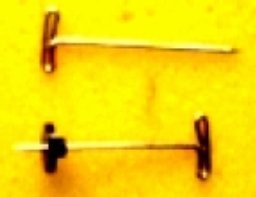
Note: Adjust brightness and contrast for optimum viewing.
T PIN.
with hold down disk.
Pins, or sharper needles, are often mounted in handles, (ie. pin vises) for easier use as straight probes or bent versions for picking up and applying CA cement, ala Al Westerfield. Not only does the bend provide a more convenient working angle, but it helps prevent cementing chuck jaws together with CA. With the ends bent back or formed into hooks, they can snag wire, springs or washers during removal. Even fine crocheting needles are helpful. Spring picks are pins with dimpled ends which are wedged between coils to hold. Some straight and flattened pins (screwdrivers) have split or bifurcated tips to hold items including screws, cements and lubricants. For the latter two, cutting the end from the eye of a needle will make a good liquid fork. Since very often tips are permanently mounted, simple handles can be made from brass or aluminum bar stock, or wooden dowel by drilling a tight fit, end hole and forcing pin into it. A drop of CA may help to secure it.
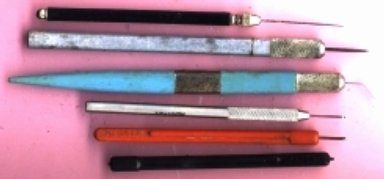
Note: Adjust brightness and contrast for optimum viewing.
PIN HOLDERS
biology probe
pin force fit
pen shaped pinvise w/ cementing bent pin
dimpled spring pic
dimpled KaDee spring pic
KaDee talgo insertion tool
Available in several sizes, most with plastic end protectors, soft wire hairpins can be bent easily to any shape to hold many items, either for stabbing into foam or with hooks for hanging. The latter are very handy around a spray booth, where they can be suspended from a rod, stretched across near the top. For larger applications, wire coat hangers can be used.

Note: Adjust brightness and contrast for optimum viewing.
HAIR PINS.
stabbing
new
hanging (brake wheels)
Many single or double sided adhesive tapes can be used for light holding. Styrofoam, wax and, more recently, adhesive putties are also useful in this area.
NOTE: Many tips or holding surfaces can be dipped in or coated with plastic, tool handle, forming liquid to provide softer, non-mar and less slippery grips. In some cases, preformed rubber or plastic plier grips and rod end protector caps can be applied.
For general manipulation of small parts _from pickup, to insertion or holding; a myriad of TWEEZERS _are available with probably the widest variety of tips, shapes and handles of any type of tool. Including locking types, they can be found at hobbyshops, drug stores, jeweler's or medical supply and flea markets. Lengths run from very short to over a foot, while tips may be from very sharp to blunt and modified for specific applications. Legs may be straight and curved or bent in any direction, to permit use at any angle. Each is designed to handle specific types of work well. A wide variety on hand and a good holder, that reveals the tips, is helpful.
Stepped locking to vary pressure, hemostats are a clamping variation, somewhere between tweezers and pliers. _They are available in various sizes, straight or curved, in hobbyshops, and other forms, used from friendly MD's, hospitals or surplus. Very similar is the non-locking ear polypus? with short jaws on a long, angled extension, which can fit into some very tight spaces. In most cases, jaws are serrated and some have soft pads. Plastic versions are safer on more delicate items and in use with caustic solutions.

Note: Adjust brightness and contrast for optimum viewing.
Polypus.
Small straight hemostat.
Curved hemostat.
Plastic hemostat.
Similar in usage, but with a much firmer grip, are PLIERS _with a fulcrum in the middle for leverage. Sizes range from very small to giant tongs. Legs vary in taper, thickness and shape. Some are curved, bent, flat, round, concave or convex; often in combinations. Some are spring opened, while others lock or are adjustable for material thickness. Much more rugged than tweezers, they are often used for bending angles, curves or loops.
Resembling crude tweezers or pliers, tongs are the quicker pickers. They are found in dining rooms, kitchens, bars, ice houses, lumber camps and industrial plants. Uses include plunking sugar or ice cubes, eating, preparing and serving food, grasping hot crucibles and tossing large blocks of ice. Ends may be points, flats, curves, spoons, cups, claws, teeth or loops. Probably the most common hobby use is retrieving items from otherwise inaccessible places including jars, sonic cleaners and behind the work bench.

Note: Adjust brightness and contrast for optimum viewing.
SMALL TONGS
hot cylinder, metal
fuse puller, plastic
American chop-sticks, for those inadept with the real things, plastic
Before supermarkets, every corner grocery store had at least one grabber, to place and pull down items on high shelves. Clerks soon learned to be quite adept in their use. Basically they are two inward curved, spring loaded tongs on the end of a pole. Through rods, trigger grips near the bottom close the fingers to grip items. Longer versions had an additional trigger in the middle for use on lower shelves. Some had hooks on the rear to snag can rims, requiring a fast catch when the can fell. Three shorter ones were used for over 25 years, in our hobbyshop, to pull and place high hook held items. By reshaping fingers and adding padded tips, these are very useful for retrieving derailed or stalled rolling stock on the layout.

Note: Adjust brightness and contrast for optimum viewing.
GRABBERS
Short, aluminum tube pole, used in our hobbyshop.
Antique 2 trigger, wooden pole, w/ hook.
To hold small parts, and to start or remove screws and nuts, a variety of grippers are available. While some have multiple fingers and others use wedging, most are spring loaded. Nut and screw holders are usually specialized. The sticker is a two flat finger grabber with bent ends having vee notches for screw shanks. Although they reduce chances of fly away, too often outside clamps inhibit access for turning.
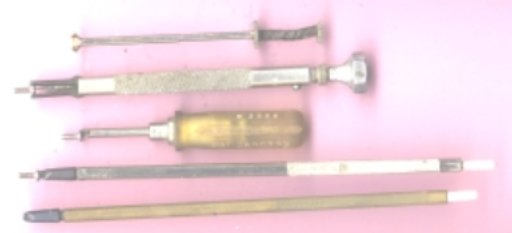
Note: Adjust brightness and contrast for optimum viewing.
NUT AND SCREW HOLDERS
Sticker w/nut, end button open
Driver w/ outside head clamp, push grab, push release
Driver w/ split diagonal wedge blade, push grab, pull release
Straight wedge for slot, push grab, pull release, end button reset.
Vee wedge for philips or cross, push grab, pull release, end button reset.
To hold small parts lightly, multi-fingered gem holders or grabbers may be the choice. Fingers may number from 1 to 6 or more and be round or flat. Common single fingers may be found on test probes. Very long retrievers are often found at auto suppliers. Some retrievers are magnetic with telescoping or flexible shafts, but they do not work with wood, plastic, aluminum or brass.
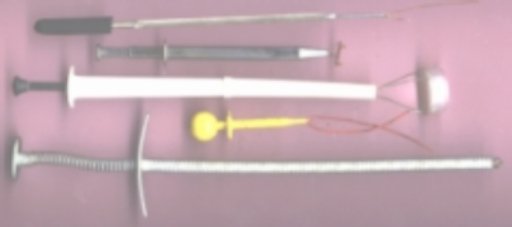
Note: Adjust brightness and contrast for optimum viewing.
FINGER GRABBERS
Fine single hook for wires, grabs and springs
Gem holder, three fingers
Jarred pickle grabber, 4 fingers
Test probe, single flat hook
Flexible retriever, 4 fingers
For more secure grips, there are several small, handle-held vises available. These are very useful for holding parts when trimming with bench grinding wheels or sanders.
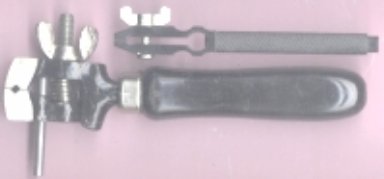
Note: Adjust brightness and contrast for optimum viewing.
HAND VISES
Small w/metal handle. 1/2" w x .052" opening.
Large w/ wood handle. 1.1" w x .64" opening.
But more convenient for comfortable, hand holding of odd shaped parts, a jeweler's ring or finding holder _marketed by Mascot is very useful. The round and square jaws have leather inserts to grip tightly without damage. Adjustable pressure is applied by wedge in opposite end.

Note: Adjust brightness and contrast for optimum viewing.
JEWELER'S RING HOLDER
holding brass power reverse for gate removal with cutoff disk.
A different approach for holding small parts is based on small 1/8", 1/4" and 3/8" suction cups. Holding light parts well, a vacuum is created by a squeeze bulb with release by a second squeeze. The smaller Model Pal uses a simple bulb with cups, while the Hobby Pal uses an internal bulb with a straight or bent tip to mount cups. More expensive vacuum pump versions are used extensively to handle surface mount electronic components. Irregular surfaces may prevent required seal.

Note: Adjust brightness and contrast for optimum viewing.
VACUUM CUP HOLDERS
Model Pal.
Model Pal..
However for most other applications, more specialized CLAMPS _ are required _ranging from clips through to vises.
With little or no external pressure, CRADLES _can hold rolling stock or structures for light work and testing, with very little effort. These may be as simple as the kit box sides or ends; used to prop the item inside or between two. Some are simply padded troughs or slings, while others are more secure with light clamping. Many have compartments for parts or tools. Some act as stands or props to hold rolling stock for decalling.
CLAMPS _ are generally used for semi-permanent to permanent holding. Variety is as wide as the imagination of the user. They may use springs, wedges, screws or elastic bands. They may be as small as screw-on earring findings or as large as long pipe or bar clamps and gigantic vises. Sources are everywhere, if their use can be recognized. Many types are found in hobby, hardware, stationary, drug, junk and dollar stores as well as jewelry and machinery suppliers.
Since many parts and some tools have tapped or clear holes, other SIMPLE SCREW CLAMPS _consist of a screw with or without a nut and washers. Parts may temporarily be held in alignment for further work. Screw machine clamps are a common example , using T nuts or screw heads mounted in slots; parts are securely held on face plates and tables. Two strips or sheets may be screwed together to form a clamp for holding others in alignment in lieu of sweat soldering.
More often mounted on the bench, or on drillpress or mill tables, VISES _ are heavier, bulkier, more robust clamps. With many variations, they can hold almost any work solidly for more forceful, hand or machine processes. Usually the base and jaws are cast and some are precision machined or ground. Many are designed for specific uses, but most can be used elsewhere. Some tilt or swivel to permit holding work in almost any position. The slides and clamping screws should be play free for precise positioning, but easy in operation. Unfortunately quality ranges from poor to excellent and too often the inexpensive are very sloppy.
Often overlooked, magnetic devices can help solve many otherwise awkward holding problems. Machinists commonly use magnetic bases to hold indicators on machine beds. With the development of ceramic magnets of all shapes and sizes, many items can be securely held on ferrous surfaces or against an opposing magnet in unique ways. The newer rare earth magnets, with up to 9 times the strength, make holding much more secure. Many paper memo clamps are fitted with magnets. Special ferrous MODELLING TRAY AND DEVICES SYSTEMS _ are available from Micro-Mark.
Very handy for keeping instruction sheets or plans off the bench, are magnetic clip boards or arm type, computer document holders for easier access.
Specialized PAINTING HOLDERS _ are very useful for brushing or spraying. They have one aim in common: Don't paint your fingers! Variety is wide, if not selection. Since the goal is to have access to every paintable surface, they must be mobile. Some are hand-held, others are free-standing; rigid or pivoted. If all else fails, you fingers in plastic gloves can handle anything.
Other types of holders exist for many specific purposes, including chucks, collets, machine tool clamps etc. Many of those applicable are covered in their areas of use. But there are times when 'none of the above' is the answer. Often very specialized JIGS OR FIXTURES _are required for peculiar jobs. Some are available commercially, but many require fabrication.
STORING TOOLS AND SUPPLIES, _ for ready access, will require other types of holders. Many tools come in cases or boxes with compartments for accessories, but more commonly, tools are loose. Clutter soon piles up and tools disappear, right in front of your eyes. Liquids may leak and ruin surfaces and objects. Common containers, from jars, cans, freezer storage boxes, pencil caddies to fancy modified racks, can be salvaged for use. An old desk makes a very convenient workbench, were items can be stored in compartmented drawers. Office drawer compartment or kitchen utensil trays are useful in shallow drawers. For deeper drawers, dividers can be installed easily or trays may be stacked. Shelves, bins, cabinets and compartmented storage boxes all help. With all these, I still manage to create a confusing mess.
BACK TO METHODS INDEX
